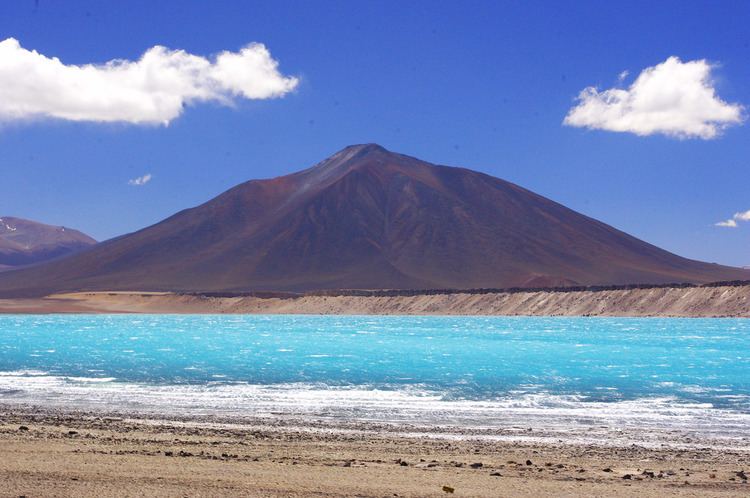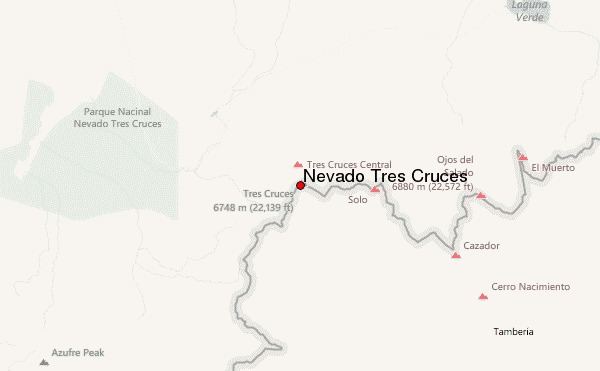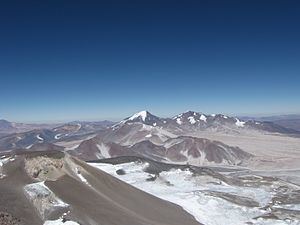Elevation 6,748 m (22,139 ft) Mountain type Volcano Prominence 1,422 m Highest point Tres Cruces Sur Mountains Tres Cruces Sur | Last eruption 28,000 years ago. Range Andes | |
 | ||
Translation Three crosses (Spanish) Volcanic arc/belt Cordillera Claudio Gay, Central Volcanic Zone Similar Incahuasi, Ojos del Salado, Laguna Verde, Cerro El Muerto, San Francisco Pass | ||
Reserva nevado tres cruces lago san francisco
Nevado Tres Cruces is a massif of volcanic origin in the Andes Mountains on the border of Argentina and Chile. It has two main summits, Tres Cruces Sur at 6,748 metres (22,139 ft) and Tres Cruces Centro at 6,629 m (21,749 ft) and a third more minor summit, Tres Cruces Norte 6,206 m (20,361 ft). Tres Cruces Sur is the sixth highest mountain in the Andes. The area was first surveyed in 1883 by Francisco San Román and the Nevado Tres Cruces National Park was established in 1994.
Contents
- Reserva nevado tres cruces lago san francisco
- Nevado tres cruces national park
- Climate and glaciation
- Geology
- Lava domes
- Recent activity
- Hazards
- References

The volcano has an extended history of activity, going back at least 1.5 million years. A number of lava domes surround the complex and a number of craters lie on its summits. The main volcano is of rhyodacitic composition and has generated two major ignimbritic eruptions, one 1.5 million years ago and a second 67,000 years ago. The last eruption was 28,000 years ago, but the volcano may become active in the future.

Nevado tres cruces national park
Climate and glaciation

The area has a desert climate, with nighttime temperatures below freezing and precipitation less than 29±14 mm in the local summer that quickly sublimates away, resulting in a lack of surface runoff and a barren landscape. The mean annual temperature is -2±4 degrees Celsius. The area is persistently very windy. The snowline altitude in the area is 5,800 m (19,000 ft), higher than the Pleistocene altitude of 5,500 m (18,000 ft). Small relic glaciers with surfaces of less than 1 square kilometre (0.39 sq mi) exist above 5,500 m (18,000 ft) with moraines visible above 4,400 m (14,400 ft). In 2000 a total ice surface of 1.1 km2 (0.42 sq mi) was reported on Tres Cruces.
Geology

The whole complex has been active for 1.5 mya and has generated two large scale pyroclastic eruptions, a first one 1.5 mya occurred on the western side of the volcano. It is fairly thin and covers Pliocene lavas. Otherwise, rhyodacitic lava flows, lava domes and various ash and tephra deposits also belong to this volcano. The three main volcanoes of the massif - Tres Cruces Sur (6,748 m (22,139 ft)), Tres Cruces Centro (6,629 m (21,749 ft)) and Tres Cruces Norte (6,206 m (20,361 ft)) formed along a local fault zone. Tres Cruces Sur and Tres Cruces Centro are the sixth and eleventh highest mountains in South America.

The massif delimits the Salar de Maricunga and has an extent of 10 km × 5 km (6.2 mi × 3.1 mi). The principal edifices are small but steep, rising 800–1,600 m (2,600–5,200 ft) above their bases. The northern cone is glacially eroded and has a crater 1 km (0.62 mi) wide. The central edifice has a crater 500 m (1,600 ft) and is inclined westward. The southern edifice is formed from an older western structure (0.8±0.5 mya) with two small craters and a glacial cirque, and an eastern edifice with a summit lava dome 2 km (1.2 mi) wide and basal lava flows. A cirque cuts the dome on the southeastern side and contains a small glacier. The whole edifice and the adjacent Miocene El Plateado volcano, as well as the western flank of neighbouring Ojos del Salado volcano, are covered with a thick layer of pumiceous ash fall, probably produced by the collapse of an eruption column. Pliocene volcanic chain Cristi (2.5±1.3 mya), Lemp (2.8±0.3 mya) and Rodrigo (adakites 4.4 mya) north and Puntiagudo south is largely buried beneath the massif. Tomographic analysis of the area has indicated the presence of a large high-attenuation zone in the crust beneath Tres Cruces and the neighbouring Ojos del Salado volcano, which may indicate ongoing or incipient melting of the underlying crust.
Lava domes
Two minor lava domes La Espinilla and El Indio are present. La Espinilla formed within the crater (150 m (490 ft) deep and 1.5–2 km (0.93–1.24 mi) wide) of an explosive eruption. This dome is 200–250 m (660–820 ft) wide and 45 m (148 ft) high and formed 168±6 ka K-Ar. El Indio is located on the side of La Espinilla away from the main massif and is larger and older (350±40 ka K-Ar) than Espinilla. Other older lava domes lie on the western flank (2.1±0.3 ka K-Ar).
A major dacitic lava dome (150–200 m (490–660 ft) thick and covering a surface of 3.5 km × 5.5 km (2.2 mi × 3.4 mi)) lies on the northwestern side of the massif, the vent is buried by younger deposits. The lava display flow banding and column jointing and has been K-Ar dated 1.4±0.4 mya.
Recent activity
Activity in the southernmost volcano has been dated at 280,000±22,000 years ago. The complex is linked to the eruption of the Tres Cruces ignimbrite 67,000 years ago, also known as Pampa Blanca. This ignimbrite is well exposed in the valley which separates the Tres Cruces and Ojos del Salado volcanoes, assuming thicknesses of 100 m (330 ft) with a basal flow 15 m (49 ft) thick. The youngest activity occurred 28,000 years ago and formed the summit lava dome of the southernmost volcano.
Hazards
The volcano has an approximate rock generation rate of 0.13 km3/ka (0.00099 cu mi/Gs), lower than other arc associated volcanoes. Nevertheless, with eruptive episodes being separated by gaps of about 40,000 years between the last episodes, dangerous eruptive activity in the future is possible. However, the region surrounding the volcano is thinly populated, so major damage to infrastructure or danger to human life is unlikely.
